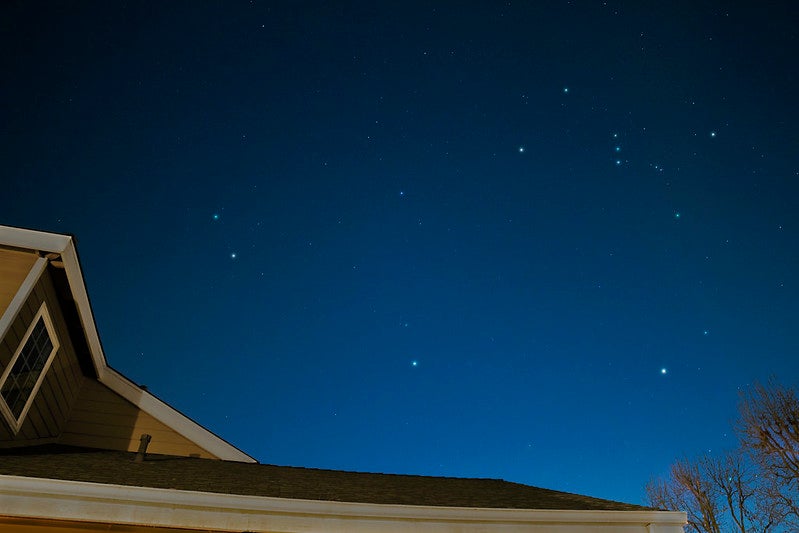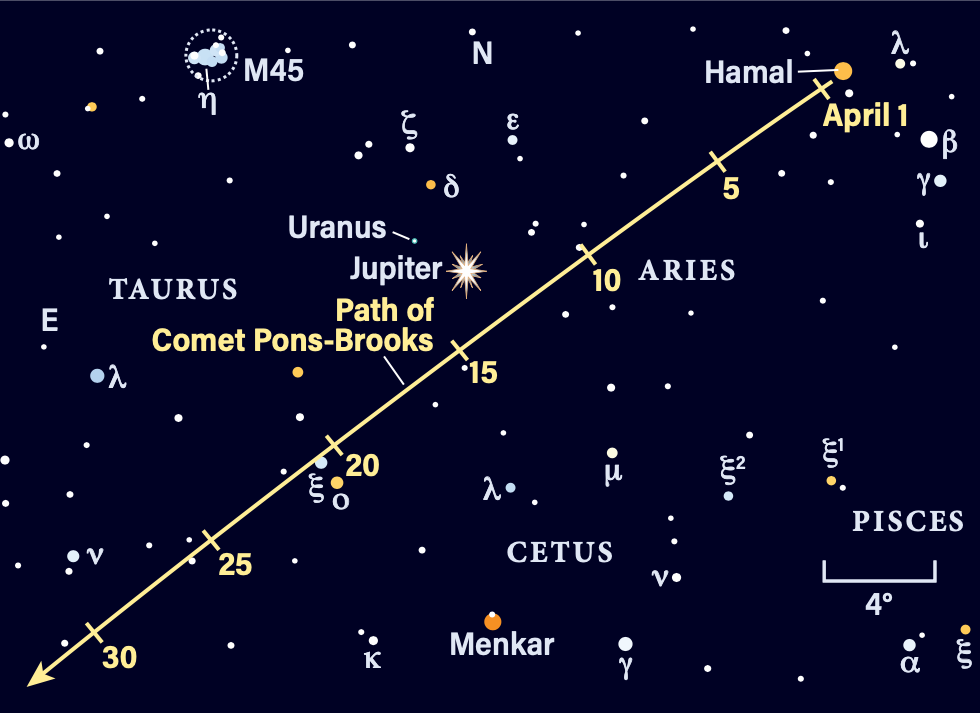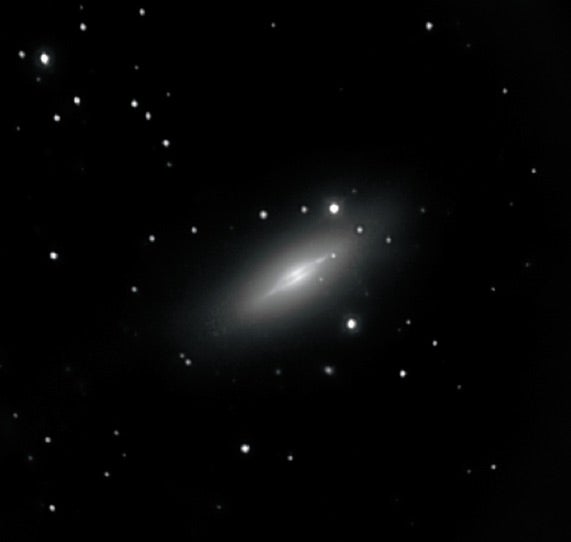
Friday, April 12
The stars famous for appearing in the wintertime sky are now setting soon after sunset these days, as spring gets well and truly underway. Look west about an hour after sunset tonight to catch the hourglass-shaped constellation Orion with his bow pointed toward the horizon, slowly sinking as he’s trailed by his two loyal hunting dogs, Canis Major and Canis Minor.
Both dogs are famous for the bright stars that mark their noses. In fact, Canis Major’s nose, Sirius, is the brightest star in the sky! Shining at magnitude –1.4, it’s an unmissable beacon to the left of Orion, standing at roughly the same height as the Hunter’s three belt stars as they set together. Knowing that Sirius is the nose, many observers can also make out a stick-figure shape of a dog extending to the left (south) of this bright star as well.
Canis Minor the Little Dog is admittedly much smaller. Generally drawn from just two stars, one of those is still quite bright: magnitude 0.4 Procyon, which stands nearly 26° above Sirius in the sky this evening. It’s a great opportunity to learn the magnitude scale, as Procyon is exactly 1 magnitude (2.5x) fainter than Sirius.
Between the two dogs sits the constellation Monoceros the Unicorn, while beneath the feet of Orion the Hunter in an attempt to escape the notice of Canis Major is Lepus the Hare.
Sunrise: 6:26 A.M.
Sunset: 7:36 P.M.
Moonrise: 8:44 A.M.
Moonset: —
Moon Phase: Waxing crescent (20%)
*Times for sunrise, sunset, moonrise, and moonset are given in local time from 40° N 90° W. The Moon’s illumination is given at 12 P.M. local time from the same location.
Saturday, April 13
With springtime often comes the return of birds in the sky. Let’s welcome back Aquila the Eagle as it rises early in the morning, led slightly by its companion Cygnus the Swan. By about 3:30 A.M. local daylight time, the two constellations stand nearly 40° high in the east, with Cygnus to Aquila’s upper left.
Cygnus’ easy-to-spot cross shape is anchored at the Swan’s head by magnitude 3.1 Albireo — a stunning orange and blue double star with a separation of about 35″ — and at the tail by brighter magnitude 1.3 Deneb, which forms one point of the Summer Triangle. The second point in this asterism is anchored by Altair, the magnitude 0.8 alpha star of Aquila. It lies about 19.7° southeast (to the lower right) of Albireo as the birds climb in the eastern sky.
If you’re curious, the third point in the Summer Triangle isn’t bird-themed — it’s magnitude 0 Vega, which sits above Cygnus and Aquila in the sky and is part of Lyra the Lyre.
For now, let’s stick to our theme and find a flock of flying birds in the pre-dawn sky: the Wild Duck Cluster (M11) in Scutum, a tiny constellation located just to the right of larger Aquila. Slide on down to the tail end of the Eagle, which lies 17.7° southwest of Altair, to land on magnitude 3.4 Lambda (λ) Aquilae. From there, it’s just a short hop 4° west to the Wild Duck Cluster, which shines with a total magnitude of roughly 6. Spanning about ¼°, this open cluster looks to many through binoculars and low-powered scopes like — you guessed it — a flock of flying ducks. Do you agree, or do you see a different image in this gaggle of young stars?
Sunrise: 6:24 A.M.
Sunset: 7:37 P.M.
Moonrise: 9:36 A.M.
Moonset: 12:48 A.M.
Moon Phase: Waxing crescent (29%)
Sunday, April 14
The early hours of the morning are the perfect time to hunt down one of the sky’s premier planetary nebulae: M27, also called the Dumbbell Nebula.
With no Moon in the sky, step outside around 4 A.M. local daylight time and look east. There, the constellation Vulpecula sits some 50° high, housing M27. Not familiar with Vulpecula? Instead, again find the more famous shape of Cygnus the Swan, then look to its right. Vulpecula and Sagitta lie sandwiched between Cygnus and Aquila, which we found yesterday morning.
M27 is perhaps easiest to find by looking just over 3° north of magnitude 3.5 Gamma (γ) Sagittae. The Dumbbell glows softly at magnitude 7.4 and spans about 8′ by 6′. Astronomy contributor Phil Harrington recommends using low power to find the small, faint smudge in the sky, then switching to higher power to pull out more detail. The nebula may appear spherical at first, but take your time and you’ll notice it is shaped like its namesake: longer than it is wide and slightly pinched in the middle. Harrington also recommends using either a narrowband or OIII filter for a more detailed view.
If you have a large (10 inches or more) scope, you might even be able to pinpoint the 10th-magnitude white dwarf at the center of the nebula. This is all that’s left of the star who blew away its outer layers nearly 10,000 years ago, creating the gauzy, ephemeral nebula we see today.
Sunrise: 6:23 A.M.
Sunset: 7:38 P.M.
Moonrise: 10:34 A.M.
Moonset: 1:48 A.M.
Moon Phase: Waxing crescent (39%)
Monday, April 15
First Quarter Moon occurs at 3:13 P.M. EDT. By sunset, our satellite is high in the southern sky, offering a perfect opportunity for viewing.
At First Quarter, the Moon’s visible face appears half lit as the terminator separating night from day sweeps westward, bringing with it lunar sunrise. Right along the terminator is the best place to focus your attention, as here is where shadows and light offer the highest amount of detail. Visible along the terminator, particularly in the lunar south, are several large craters including Hipparchus and Albategnius.
We’ll return to the Moon next week as it’s nearing Full, so take a good look at the features that are visible (and just barely visible, on the night side of the terminator) now so we can compare the view later!
The Moon tonight is in Cancer, placing it near a stunning open cluster called the Beehive. Cataloged as M44, this group of young stars lies in the center of Cancer, just over 9° southeast of the Moon’s position today. At magnitude 3.7, M44 is visible to the naked eye under good conditions; however, the Moon’s proximity may bump up the challenge enough so that you require binoculars or a small scope, tonight.
And do start with low power — because it spans some 95′, M44 is best viewed under lower power to pull in all its members, of which there are some 350. Then consider “zooming in” with higher power or a larger telescope, which will bring out more stars but show only the core of the cluster.
Sunrise: 6:21 A.M.
Sunset: 7:39 P.M.
Moonrise: 11:38 A.M.
Moonset: 2:36 P.M.
Moon Phase: Waxing crescent (49%)

Tuesday, April 16
Northern Hemisphere skywatchers, this could be one of your last views of the comet 12P/Pons-Brooks as it passes near Jupiter and Uranus on its way toward perihelion (the closest point to the Sun in its orbit) on April 21. The comet is quickly fading from northern skies, though it will soon become visible south of the equator.
You’ll find Pons-Brooks about 12° high half an hour after sunset. The comet is passing just 4.5° south of Jupiter today, offering a great photo opportunity. You may even be able to catch Uranus, which sits an additional 1° north of Jupiter. All three are in Aries the Ram.
Let’s start with Jupiter, as it will be our signpost in the twilit sky. The gas giant hangs about 15° high in the west 30 minutes after the Sun disappears, shining at magnitude –2. It will be the first bright point of light to pop out of the falling darkness, serving as an “evening star.”
Pons-Brooks lies to Jupiter’s south; the comet is hanging around magnitude 4 and has not had an outburst since last week. Some may have spotted it in binoculars during the total solar eclipse! The comet’s nucleus and coma are bright and astrophotos should pick up their green glow. The tail is faint but similarly shows up fantastically on photos.
Let’s skim our gaze back to Jupiter, where all four Galilean moons are on display. Io sits alone to the east, while Europa is closest to the planet in the west, followed by Ganymede and then Callisto farther out. Europa is heading for an occultation, when it will pass behind Jupiter around 11 P.M. PDT — the only time zone where this event may be visible, though the planet will be very low on the horizon at that time.
Uranus glows a faint magnitude 5.9, readily visible in binoculars or a telescope. It spans just 3″ and may look like a grayish-colored, “flat” star.
As the sky starts to darken, note that the Pleiades open cluster (M45) in Taurus will appear, hanging above the whole scene as it sinks toward the horizon.
Sunrise: 6:20 A.M.
Sunset: 7:40 P.M.
Moonrise: 12:42 P.M.
Moonset: 3:15 A.M.
Moon Phase: Waxing gibbous (59%)

Wednesday, April 17
Look to the north tonight and see if you can identify the long, winding body of Draco the Dragon, which curls around the Little Dipper to the right of that asterism late this evening.
Near Draco’s southern border with Boötes is the Spindle Galaxy (NGC 5866). You can find the galaxy by scanning just 4° southwest of magnitude 2.2 Iota (ι) Draconis. This edge-on lenticular is a bit challenging at magnitude 10, but it’s still a favorite of many observers. The galaxy appears surrounded by several field stars, which are intervening suns in the Milky Way that sit between us and this extragalactic target. Even those with a small scope should be able to find it, though larger telescopes will show more detail — including a dust lane along the galaxy’s plane and the oval-shaped bulge that has earned it its name. You may find that using averted vision, or looking away from the center of your eyepiece toward the edge, makes it pop out well in the corner of your eye.
The Spindle Galaxy is a decent 5′ across at its longest point — which, at its distance of about 50 million light-years, translates to a physical size of about 60,000 light-years.
Sunrise: 6:18 A.M.
Sunset: 7:41 P.M.
Moonrise: 1:46 P.M.
Moonset: 3:46 A.M.
Moon Phase: Waxing gibbous (68%)
Thursday, April 18
Asteroid 3 Juno is stationary at 11 A.M. EDT. You can find the 10th-magnitude minor planet hanging out near the Moon tonight in Leo the Lion, with our satellite providing a great jumping-off point to find one of the largest asteroids in the main belt.
Wait an hour or two after sunset, when the sky has grown dark. Then, find the Moon — it lies between the front and back legs of Leo, just beneath the Lion’s body in the southeast. Our satellite is now some 80 percent lit, well on its way toward Full.
Juno sits just 2.2° south of the Moon. The asteroid is also less than 1° north of the 4th-magnitude star Rho (ρ) Leonis, further aiding in finding it. And the entire group lies near 1st-magnitude Regulus, the heart of the Lion, which sits about 6.4° west of the Moon.
Pull away from the scene a bit, in fact, and focus on Regulus. This star serves as the anchor for the base of an asterism called the Sickle of Leo. From Regulus, look north to magnitude 3.5 Eta (η) Leo — this is the top of the handle. From there, travel clockwise to the stars Gamma, Zeta (ζ), Mu (μ), and Epsilon (ϵ) Leo. These form the curved blade of the Sickle.
Sunrise: 6:17 A.M.
Sunset: 7:42 P.M.
Moonrise: 2:47 P.M.
Moonset: 4:11 A.M.
Moon Phase: Waxing gibbous (77%)
Friday, April 19
Although several planets line up in the early-morning sky — including Mercury, which is starting to extend its distance from the Sun — most will be difficult to see soon before dawn. Nonetheless, Saturn and Mars will be on display in twilight, inviting observers with telescopes and a clear eastern horizon to enjoy the scene.
Let’s start with the highest planet, Saturn, which is about 6° above the eastern horizon an hour before sunrise. You should be able to spot its 1st-magnitude glow in Aquarius without any optical aid, but you’ll want a telescope handy to reveal the planet’s stunning rings. Saturn’s disk is roughly 16″ wide, while its rings span about 36″. Those with excellent eyesight, a dark horizon, and good seeing my also spot the planet’s largest moon, Titan, just north of the disk.
Next, slide your gaze just under 6° east (to the lower left) along the ecliptic and you’ll come to magnitude 1.2 Mars. The Red Planet should indeed appear red-hued against the pale blue background of the sky. Its disk appears tiny, just 5″ across, making features difficult to discern.
About 7.2° east of Mars is Neptune. The distant ice giant has just cleared the horizon an hour before sunrise and may be extremely difficult to see even as it rises because the sky will start brightening quickly. Neptune is magnitude 7.8 and a mere 2″ across, making it difficult to differentiate from a dim star in the turbulent air near the horizon.
Mercury and Venus are also rising, but are just a few degrees high (if that) by the time the Sun peeks over the horizon. Furthermore, Mercury is only magnitude 3.4, rendering it effectively invisible at this time. We’ll return to view the solar system’s smaller planet soon, though, when its distance from the Sun and its brightness have both increased.
The Moon reaches apogee, the farthest point from Earth in its orbit, at 10:10 P.M. EDT. Our satellite will sit 252,043 miles (405,624 kilometers) away at that time.
Sunrise: 6:15 A.M.
Sunset: 7:43 P.M.
Moonrise: 3:48 P.M.
Moonset: 4:34 A.M.
Moon Phase: Waxing gibbous (84%)

Sky This Week is brought to you in part by Celestron.









